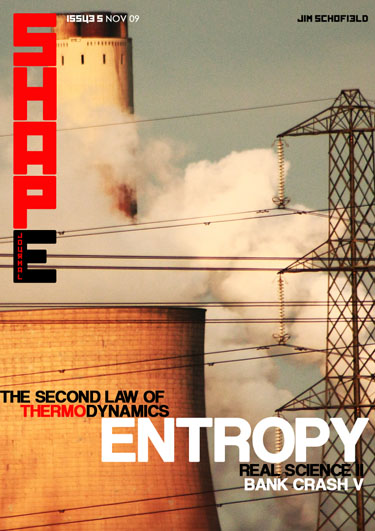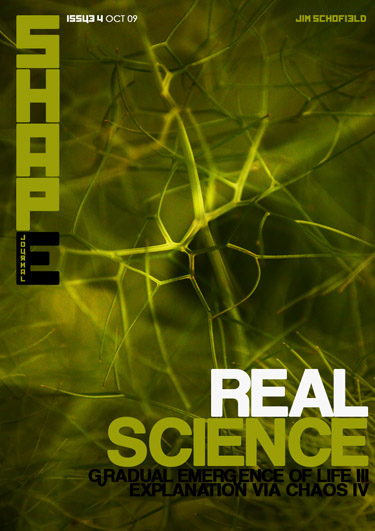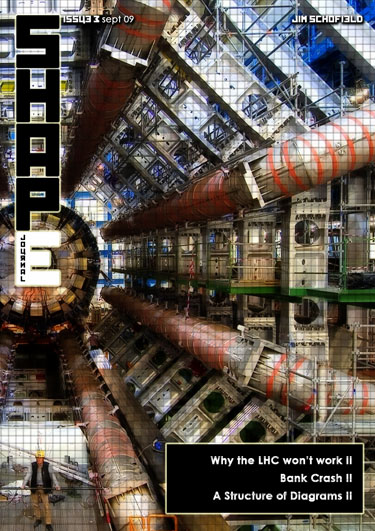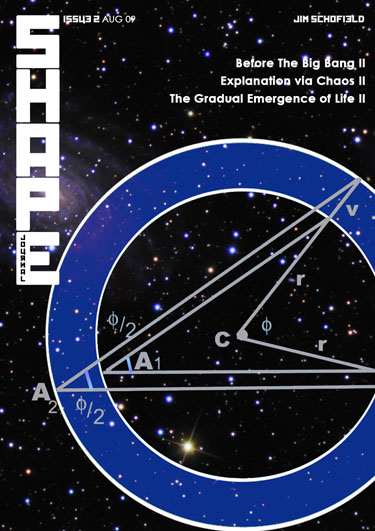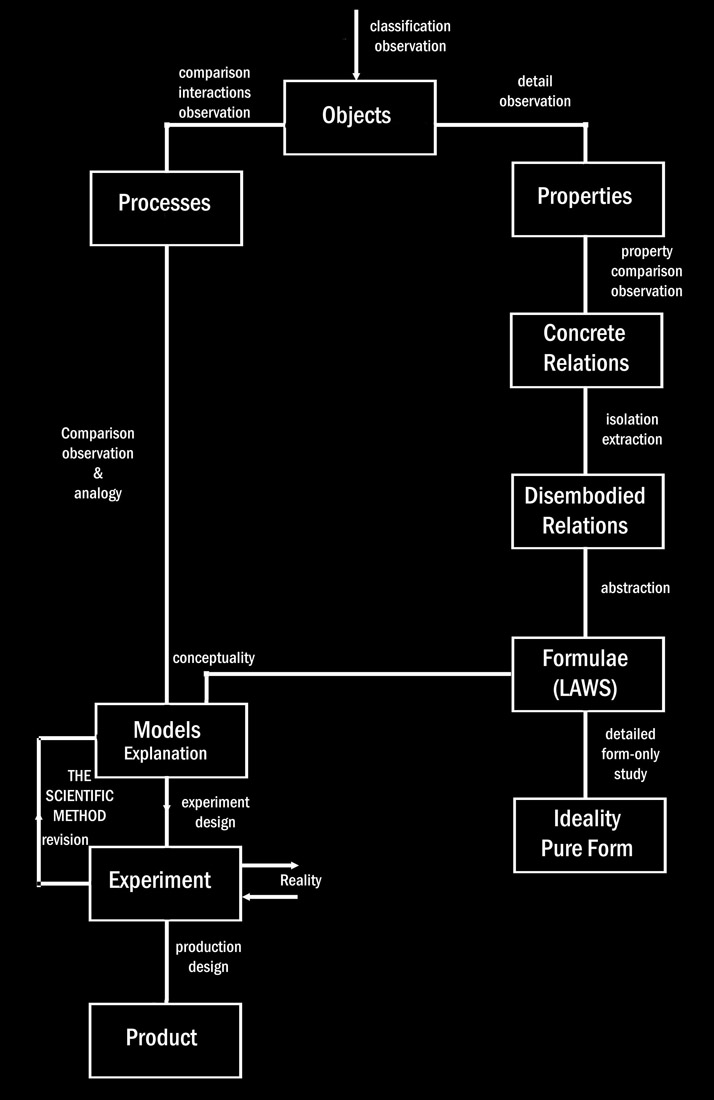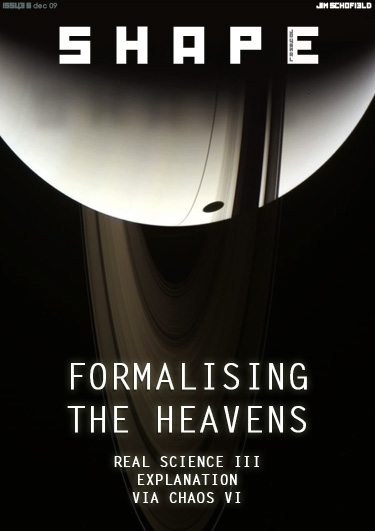
15 December, 2009
09 December, 2009
Eureka! It's Populist Science

"...On reading the current issue [Eureka Magazine, The Times, Nov 5 2009] from cover to cover, I was surprised to find that really nothing new was presented there at all. It reminded me of New Scientist, but whereas that journal is aimed at “scientists” (supposedly), this one is certainly aimed at the “interested layman” in mind instead. And one of the characteristics of such disseminations is that they are totally subservient to the “experts”.
No longer do we have hostile antagonisms by arts-types and other non-believers, but in the new attitude of embracing Science in all its current glory, all the participants merely swell the ranks of the consensus merchants, who “wonder” at the might and power of Big Science as propagated by its producers. This removes that absolutely vital criticism which Science has always needed to continue to progress, and which is now, more than ever absolutely essential, as its ageing philosophy and consequent methodology becomes increasingly inadequate to cope with the major unanswered questions that are daily arriving at the top of every agenda..."
The Fruits of Asymmetry

Tessellation utilising re-entrant polygons
(in this case using a singly re-entrant asymmetric hexagon - or "L tile")
(in this case using a singly re-entrant asymmetric hexagon - or "L tile")
"...What was evident to me was that the essential component in these formal investigations was Symmetry! While my colleagues in Physics were totally wedded to complete maximal Symmetry (and indeed Super Symmetry), I was finding that instead of the limited numbers of tilings and crystal forms that were available to them, I was finding (in 2D at least) a seeming infinite complexity of Forms. With maximally symmetric units, these all funnelled down into a minimal set, but with re-entrant forms (the first deviation from maximal symmetry), and various regular asymmetries, the possibilities were vastly increased.
Indeed, from monolithic tilings (using a single basic unit in a single way) there occurred a wide range of hierarchical forms, which could be different or mathematically similar at each succeeding level."
To read the rest of this paper, click here
Diagrams on the Science of Music
22 November, 2009
04 November, 2009
Forms & Causes - What's the Difference?
Forms are frequently recurring patterns, which appear in all phenomena, and seemed to be the crucial indicators of the nature of these happenings and their involved entities. All our earliest characterisations of things were unavoidably on the basis of their Form, and things with closely similar Forms would initiallyalways be inevitably grouped together as “closely related”. But, this didn’t usually hold up, as many members of such “groups” later turned out to be hardly related at all: they merely had the same Form. So Forms are not particular and fundamental, but universal: the same forms appear in many different, andcertainly not causally-related, situations. So, though common patterns do recur, and hence need explaining, they are quite different to the more physical causes: they can be common to many unrelated, and differently-caused things.
Now, in addressing why this is, and how Form is characterised by it, we have first to address the other, indeed the primary, consideration, which is what actually physically causes the identified phenomenon!
It is clear that quite different causes, in widely separated areas can display the very same Form, but that this is almost never because they all have exactly the same actual cause. Yet, this being true, why are the Forms themselves so recurrent? They must reflect similar patterns, weights and conjunctions of contributions. (Notice that the conjunctions themselves are not directly involved. It is the MIX that determines Form. Forms must be the natural shapes ofrecurring types of mixes, even if the physical causes of the involved contributions are unrelated. This feature of Form can make it extremely valuable in predicting what is likely to happen next. But, we must also notice that to “follow the Form” in this way does NOT mean that we understand the producing causes, but only the shape, or pattern, of what follows.
These questions are very important because, when asking those who address them what they think, alarge fraction of them insist that the Form is primary, indeed they tend to consider each Form as a kind of immaterial Essence, the makes things the way that they are. Consequences are considered to be driven by Form! Now, this is important because the physical causes can be missed in the worship of assumed Essential Form, and actual causes are not then directly sought for: they become unnecessary if the essential driving forces in Reality are just the Forms. Why do we need more?
Mankind has developed a powerful set of techniques for dealing with Form, and perhaps the most significant stage in its progress has been their distillation into Formulae – into general equations which are abstract mathematical representations of measurables within given Forms.
My Mind to Me A Kingdom Is
The myth of the philistine scientist is not about experience, it is about prejudice. And the sentiments of Sir Edward Dyer express Mankind and not merely the artistic subset...

In Praise of a Contented Mind
My mind to me a kingdom is;
Such perfect joy therein I find
That it excels all other bliss
That world affords or grows by kind.
Though much I want which most men have,
Yet still my mind forbids to crave.
No princely pomp, no wealthy store,
No force to win the victory,
No wily wit to salve a sore,
No shape to feed each gazing eye;
To none of these I yield as thrall.
For why my mind doth serve for all.
I see how plenty suffers oft,
How hasty climbers soon do fall;
I see that those that are aloft
Mishap doth threaten most of all;
They get with toil, they keep with fear.
Such cares my mind could never bear.
Content I live, this is my stay;
I seek no more than may suffice;
I press to bear no haughty sway;
Look what I lack my mind supplies;
Lo, thus I triumph like a king,
Content with that my mind doth bring.
Some have too much, yet still do crave;
I little have, and seek no more.
They are but poor, though much they have,
And I am rich with little store.
They poor, I rich; they beg, I give;
They lack, I leave; they pine, I live.
I laugh not at another’s loss;
I grudge not at another’s gain;
No worldly waves my mind can toss;
My state at one doth still remain.
I fear no foe, nor fawning friend;
I loathe not life, nor dread my end.
Some weigh their pleasure by their lust,
Their wisdom by their rage of will,
Their treasure is their only trust;
And cloaked craft their store of skill.
But all the pleasure that I find
Is to maintain a quiet mind.
My wealth is health and perfect ease;
My conscience clear my chief defense;
I neither seek by bribes to please,
Nor by deceit to breed offense.
Thus do I live, thus will I die.
Would all did so as well as I!
27 October, 2009
The Cradle of Life - New Scientist is at the vents again...

(Comments on the recent New Scientist article)
1. “Necessity is the Mother of Invention”, but you also need the Funding!
An article entitled The Cradle of Life in New Scientist (2730) is an interesting contribution to this discussion, but in a rather surprising way. Throughout the piece the author, Nick Lane, of University College, London brings forward the works of Peter Mitchell, along with those of Mike Russell, of NASA, to explain the Origin of Life! But, he repeatedly uses the verb “to evolve”, which is a surprising choice for the transition from inanimate Matter to Living Things, and you might think that these contributors are finally moving towards an Emergentist position.But, that turns out NOT to be the case! The use of “evolve” is well within the generally agreed use because the contributions detailed in the article do not actually address the Origin of Life. The title The Cradle of Life gives it away, because what is presented here are the earliest developments inLife after its Origin. Surely, a site for the actual Origin would be called something like the “Crucible of Life”. A Cradle is aprotective environment for a Life already born!
Now, I have been arguing for many years against that School of explanation on the Origin of Life, which looks solely to pre-existing processes within the preceding non-Life Level, and I argue against their whole approach and “revealed causes”, because they do NOT explain the actual Origin at all. Even the contributions of Miller and Oparin were NOT the causes of the Origin but merely pre-requisites for when the real and appropriate causes did finally appear.
Here we encounter a similar approach, but this time working downwards from within the Life Level, and burrowing as deep as possible towards the actual Event of Life’s Emergence. But, in both these approaches there is a basic assumption which prevents them ever unearthing the actual causes.They assume the usual banker of Reductionism - that continuous links which connect each and every phenomenon with its causes, are appropriate right through this revolutionary transition also...
The Time Has Come To Bury The Dead
Friends, colleagues, scientists, listen to me!
The scene all around us is littered with the dead and dying and the war is finally won.In order to proceed we must, clear this present carnage, and in an orderly and respectful way,bury the dead, and proceed to construct a New Order.But first, we must identify each and every lifeless corpse, certify their demise, and with dignityconsign them ALL to the ready earth.There are those, still standing, who would deeply mourn the passing of these heroes, and theyare honourable men, but I must be true to myself and boldly declare that I do not truly mourntheir passing. Nonetheless, I am here without hindrance from their still powerful supporters, tojustify the evident slaughter, so it is clear that they are all honourable men.So, let us begin. Let us start with the leader of all these men, both dead and still alive, theindomitable Rock against Change; the veritable Cause of the recent war.Yet, we must be charitable, as his friends are now clearly charitable in allowing me to speak toyou now - for they are truly honourable men.Here lies Plurality, for that was his true name, who in spite of his many grievous wounds (someinflicted over 2,500 years ago by the mighty Zeno), did stand and fight until now, when he hasfinally and irretrievably halted by death. Let us intern him, and all his colleagues with duehonour, by clearly crediting him with what he gave us, that you all, I am sure, could recount,and cover him up FOREVER!
Plurality stated clearly, and it was agreed by all to be the certain truth, that every Whole is made up ofseparate Parts, and indeed this profound premise DID open the door to a simplification of the World in orderto study it. Now, Pluralism has at least one hidden partner. If we are to isolate the Part from the Whole andignore all connections, links and even causes EXTERNAL to the Part, we are similarly easily pressed into also ignoring all trivial and clearly negligible relations, which STILL pertain after isolation. Indeed, howcould we determine from where cometh any tiny variations still evident, after we have established our Partdefiningconditions? We can’t do it!So we say that maybe the isolation is not absolutely perfect, and therefore, following our principle of deepstudy of ONLY the dominant relations of the Part, we exclude what else we can, and also ignore what wedon’t seem able to eliminate entirely. Whether these tiny variations are small still-existing links with the restof the Whole, or trivial-but-contained relationships WITHIN the Part, we dump them any way.So, this partner of Pluralism can be called Simplification – the dumping of the inconsequential!
16 September, 2009
Recursive Tessalations
10 September, 2009
Dreaming of Jupiter
The Dream
Last night I had a dream...
I must have been thinking a great deal about the problem of holisitic, emergent change before I dozed off, because my dream 'solved' the problem in a very beautiful, purely filmic way.
No concepts were involved, no intellectualism - only a sequence of images in glorious technicolour. Entities, as areas of colour, were being changed into other entities, easily distinguished by their clearly evident changes in characterisitic hue. Things were constantly appearing and disappearing, but NOT according to any single mathematical rule. The happenings evidently depended on what entities were present, what they seemed to absorb, and what they produced. The ever-changing context seemed to be crucial in what the sequences of changes were. The most important feature seemed to be the creation of localities, which tended to have some sort of persistence. These appeared to be dependent upon certain preponderances of a particular type of entity. And within these localities the changes occurring were either small or involved sequences or cycles of processes and entities.
But, most interestingly, it was around the edges of the localities that the quickest tempo of changes occured. The best picture of what was happening was that it seemed like the Great Red Spot of Jupiter. Just as there, the spot itself seemed permanent, but involved cycles within it, whereas around the edge, things were happening much more dramatcially, and could either be sucked into the Spot or emanate from it. Other peripheral activities seemed to sail by with minimal interaction. Sometimes various appearances in the border region seem to accelerate away and from a different new locality.
This dream was purely visual, but of breathtaking beauty. It reminded me of watching a rough sea on rocks. It implied incessant, constant cause, but infinite possibilities. The dream though was much more cogent and simplified. It was like an abstract symphony of form and colour.
On waking, my mind was filled with thoughts that imagined all sorts of significant events that had occured and precipitated an interlude of changes, before something else took hold and drove the patterns onwards. It was clear to me that the periferies of the relatively stable localities were special. Within the main localities, too much was constrained, while outside of every locality nothing seemed to be present for long. Colour succeeded colour in rapid succession. At the boundaries there certainly seemed to be a reliable provision of resources from within the locality, while elsewhere on this periphery the locality's edge was itself being fed by the absorption of passing entities. But while peripheral forms were being supplied from within the localities, they were also in immediate contact with the external churning void. When it came to a budding off, it was clear that the dependence on the parent locality was no longer necessary, and each offspring gathered around itself very similar peripheral streamings as were present around the main locality. The "Great Red Spot" was producing new entities which could then exist anywhere within the chaotic soup in the same way as the parent did.
Now, I am well aware that this was only a dream, but where do we start addressing the intractable problem of Emergent Changes?
26 August, 2009
Empty Photons?

A Basis for the Speed of Light
My recent musings on the actual contents of 'Empty' Space, have led to a position in which I now postualte that it is packed "full" of what I term "empty photons". Now, of course, such a conception poses a series of questions. For example, what happens to a photon of zero energy content? Can it continue to exist? Also, what might such photons actually do? If they had movement, it would seem that they should continue to move. And what happens when such photons collide?
I have NO idea of the answers to any of these questions, so that in the following muse, I will have to make the best assumptions that I can muster. If you thought neutrinos were a conundrum, how about zero-energy photons?
Now, my idea of empty photons seems to fill in the answers to a few of my recent self-addressed questions on the Speed of Light. If Space is full of photons with very, very low (if not zero) energy content, and these are the carriers of all E-M radiation, then the situation can be likened to an enourmous box, packed full with snooker balls. Any disturbance on one of these balls will be immediately transmitted to all immediately adjacent balls, then these, in turn, will deliver the distrubance onwards by the same method. The Speed of Light with this model is then NOT the speed at which a photon travels in totally empty space, but, on the contrary, the speed at which transfers take place photon-to-photon. The photons stay where they are but pass on the E-M disturbance. Also, the Speed of Light does not present the usual conundrum of somehow being independant of the speed of the producing source. Obviously, with this model, the speed of any source is irrelevant. Indeed, this Speed becomes a property of light's transmission medium - the packed photons which constitute Space itself.
The Michaelson-Morely experiments do not present an inexplicable contradiction, but, on the contrary, give excellent evidence for my case here. Any disturbance is immediately transmitted to Space itself, which, when composed solely of its empty photos, has a FIXED speed of transfer, which equals C - the Speed of Light. Notice that whenever the disturbance has to travel through Matter it is slowed down, and related to its frequency or colour, whereas all light in Space of whatever frequency is propogated at the exact same velocity = C. Notice also, that our model of packed photons makes for good simplification of wave propogation in Space too. The disturbance being communicated equally in all directions, with a leading edge (or Wave Front). Important features such as interference are also straight forward products of this model, as particular photons would receive disturbance from two seperate sources and would either sum or cancel just as required.
Remember, of course, the disturbance is an E-M one - it involves NO consequential movement of the photons. Their movements are quite seperate, and exactly what they will be, requires some more thought. Certainly, the packing of these photons is not obvious. Maybe they are as tightly packed as our snooker balls-in-a-box. They don't need to move to communicate E-M disturbances. Indeed, they could be in incessant movement with inumerable mutual collisions, for these would not affect their role in propagation (as is the case with sound waves through a gas). What is clear is that if collisions of photons did take place, and caused changes of direction, there could be a completely "random" spread between the resultant directions by now, and this would perhaps facilitate the propagations by effectively making the movements cancel out and be irrelevant. I can conceive of the photons not moving very far at all, but subject to so many collisions, as to be seen as to be vibrating.
Certainly the theory of empty photons is in its infancy, but I will publish another more in depth paper on the subject via the Shape Journal very soon. Watch this "Empty" Space.
14 August, 2009
07 August, 2009
The Search for Holistic Science
THE SYNOPSIS OF THE PROPOSAL FOR A NEW MILLER’S EXPERIMENT PAPER IV.
- Miller's experiment was holistic! It used pluralisitic means, but for a different purpose: it was to keep the initial primaeval mix unadulterated. It's controlled mini-world was a Model of the primaeval world before Life.
- But what had actually happened in the apparatus was, and still is, unknown, and could thereafter ONLY be used as an argument for the natural Origin of Life, but not exactly how it occured. It was not, and could not be, followed up.
- This, and many other experiments (such as those by Oparin), couldn't be carried further because of current experimental method and its generated assumptions about Reality. The crucial missing element was an awareness of the role of Emergent events.
- Indeed, even after Emergences were recognised as having occurred, their content was wholly unknown, and experiments such as those by Miller & Oparin were misinterpreted as being part of those events, whereas they were really only necessary precursors happening prior to the precipitation of the revolution itself.
- A random-chance conjunction of all these precursors became the standard assumption as to how Emergences did what they did, but that model was certainly quite mistaken. For it involved a wholly positive, tide-of-progress process and Emergences were certainly NO such events.
- They were, initially at least, cataclysms of destruction, wherein the past stabilities were first gradually and then acceleratingly, dismantled into a kind of chaos. The usual model, on the other hand, assumed that a trillion-to-one chance would definitely happen if Reality had 1 trillion chances, but that retrospective definition cannot be applied to creation.
- An Emergence had to radically alter probabilities. And it did just that! The initial phase conformed with the famed Second Law of Thermodynamics, and resulted in something very like chaos. But in so doing it provided the conditions for a new start, and impossible odds were first shortened to probable and then to inevitable.
- In fact the significant precursors for an Emergence were mostly those pressing towards a dissolution of the status quo, and such a disaster would always be the initial outcome. But as all positive feedback avalanches also contain the necessities for their own termination, so it was with Emergences.
- The second phase of a completed Emergence would always be one in which the detritus of the old regime, plus the unfulfilled possibilities such as are demonstrated in Miller's Experiment would come together in new ways in the creation of a wholly new regime.
- It must be the content of the processes of an Emergence which will provide the ground for the creation of a vital new approach to Science. The whole trajectory from incipient breakdown, through total dissolutions, and then upwards to a new regime, with new possibilities, must be tackled and solved.
- The first ideas currently suggested are of a series of avalanches of Change, removing the old maintaining processes, which subsequently allowed new mutually conducive, and hence mutually supporting processes to emerge as part of a wholly new order.
- The crisis at the end of the Cretaceous was such an Emergence, and the gains of Cosmology in the 20th century were also replete with other Physical Emergences in the Evolution of the Universe.
- But these are, as yet, NOT co-ordinated into a new hollisitc Scientific Method which addresses unfettered Reality directly!
- Even the mass of pluralist scientists have implicitly taken on the hollistic World in their attempts at Simulations. But they do not have a methodology, and instead impose a 'Threshold & Switch' method of dealing with qualitative Change. It will not do in dealing with creation...
This is of a paper written in July 2009, which was proposed would be published in the SHAPE Journal sometime in 2011, but it certainly cannot wait its turn in that very long queue, so it is flagged HERE and NOW, by this synopsis, and made available in full to all those interested in this vital and revolutionary area of research. The work involved is surely too broad and important to be undertaken by a single individual, and it is hoped that this publication will elicit a response form those who agree with the quest, and even from those who would like to participate.
You can download the PDF of paper IV here
27 July, 2009
Fractal Unreality?

In yet another missive from Mark Buchanan, entitled Fractal Reality (appearing in New Scientist No. 2701), he continues his clearly self-assigned task of papering over everything in Quantum Theory that is evidently unreal and false. He does this with yet another carefully brought together layer of the usual mathematical formalism, but without showing any of the mathematics, and instead talking about them as if the involved formal entities actually exist in concrete Reality. In doing this he has the decided advantage of merely reporting the work of others, who more directly but “specifically” do the same thing. By his method, he can pick-and-mix between alternatives to produce a fabric of what seem to be competing notions, but which are in fact from a very closely related, and generally agreeing, group of mathematical scientists, working in an area that they can only deal with by totally abandoning Explanation. Buchanan’s approach gives the impression that the real choices are between the “contending” members within this consensus, and certainly NOT for, or against, Quantum Theory. In a relatively short article (2,800 words) he covers, as usual, a great deal of ground, and his reportage approach means he does not have to explain or justify each and every one of his identified alternative strands (how could he in 2,800 words). And he pays his readers the “compliment” of implying they “know all that stuff anyway”.
So, with a mass of fragmentary offerings, plus a liberal addition of attractive images and “information panels” (for those who have forgotten such things), he offers up a heady mix. I have written before about his approach epitomised by his regular articles in New Scientist, so I must leave my critique of his method here, and instead attempt to plumb the depths of the mathematical speculation on which he is reporting.
Buchanan admits from the outset that Quantum Theory is hard to take, and once again relates the old arguments between Einstein and Bohr on the counter-intuitive, contradictory, and indeed often idealist elements of the Theory. The hoary old “issues” get resurrected to obscure the real and unaddressed problems, with the emphatic statement that “the Theory’s extraordinary success in explaining the behaviour of….quantum events” justifies its acceptance”. Of course he cannot mean explain, for he is talking of equations: so he must be using that word to give more weight to the more correct word predict, which is what Quantum Theory does. And they are not the same thing at all! The whole history of Science is littered with such mathematical predictors, which in spite of their predictive success, were in fact misleading and implied quite incorrect explanations. , Of course, even such things could not be totally arbitrary inventions, or they would not predict so well. But, the major error of this sort of Science is revealed, and shows that pattern matching is insufficient. It works only for essentially blinkered, pragmatic Science, but delivers NO integrating or understandable, overall view.
So, why is this correct prediction possible? The answer is in their Forms! They may not explain but they DO indeed fit! They do have appropriate Shape, and it is this Form, and Form alone, which allows quantitative prediction.
BUT, there are , of course, many Forms, in appropriately constrained conditions, which are extractable from Reality, but the interesting thing about them is that they are universal: they also fit multiple unrelated areas for each and every individual Form. All the scientists have to do, once they have determined “appropriate Form”, is carry out a detailed “fitting operation”, using sufficient data from experiment to accurately evaluate all constants associated with their chosen general Form, to make it fit tightly in all the right places. The fact that it can then fit experiments with such accurate predictions should surprise no one. After all, an equation is a succinct embodiment of a whole set of measurements from Reality, without which NO prediction would be possible. The whole task of the “discoverer” is to recognise pattern – that is Form, and to know how to condense multiple readings into such a minimised abstract “shape”.
Now returning to Einstein versus Bohr, they were BOTH unrepentant mathematical physicists: BOTH sought these well-fitting Forms via the methods I have briefly described, but they differed in philosophy somewhat. Whereas Einstein expected that the Forms would ultimately be explained in terms of a Real World, and thus complete the full task of Science, Bohr was a dyed-in-the-wool pragmatic mathematician, who actually rejected such an expected explanation in that particular realm of study as completely impossible – forever! He had absolutely NO patience with those who continued to try to “uncover” such explanations. He did not care one whit that his equations (and how they were used) involved totally inexplicable elements (indeed contradictory elements). He trumpeted, “Do they work?”, and answered his own question with a resounding “Yes!” But he was wrong to leave it there!
Science is not purely about prediction in tightly defined circumstances – we have another name for that! We call it Technology. Science, on the other hand, requires explanations! Why? – because it is understanding which takes Science forward. Bohr’s pragmatic agenda brings it to a dead stop as a developing means of understanding Reality. Each and every equation was, for him, the end of the process of “scientific endeavour”. Thereafter, for Bohr no science was necessarily involved.
What was involved, in this approach, were two consequent lines of “research” The first was wholly formal – purely mathematical! The equations themselves were “researched”, and reresearched ad nauseam . The clincher to reveal exactly what this type of “research” is, appeared in a previous issue of New Scientist, when a correspondent claimed to have discovered a Worm Hole big enough for a whole spaceship to pass through. Questions such as “Where is it? Tell me the location?”, of course went unanswered, because he hadn’t done any scientific research, neither had he discovered anything. He had, in the comfort of his office and sitting at his desk, and, of course, with sufficient sharp pencils and sheaves of paper, he had done some mathematics. He had constructed a version of the appropriate equations that “fitted” his claimed scenario. It wasn’t even of the legitimate type of “fitting” that I described earlier, for he had NO new data from even from either experiment or observation at all. What he did was dream up data and see what effect it had on the “properties” of the agreed mathematical forms. He was importing pure speculation into the purest mathematics.
The second possible route for so-called research is even more amazing. As old fashioned Explanation had been permanently dumped, its use was prohibited, and this left our mathematical scientists somewhat illequipped. But if the equations could be “mined” to reveal formal elements, which could be taken together into some kind of “new entities”, this might well be legitimate and even “clarifying”.
The source was no longer Reality for any new entities. They were instead to be found in the equations.
This was surely a remarkable development! For along with a Ground of entities carried over from “old fashioned science”, a new amalgam was unashamedly constructed involving these new “legitimately mined” entities from within the trustworthy and perfect mathematics alone.
Why do I condemn such methods? It is because they leave the supreme arbiter of Reality behind. And I am also not impressed when later experiments are said to “reveal” these inventions as “confirmed”. What else would they do? Data from Reality was the raw material for the original equations, and these were then re-interpreted into “entities” involving certain aspects of the equations. It would therefore be a total shock if new data contradicted the merely “re-packaged”original data, would it not? Interpreting confirmation of the old data from the new as confirmations of their speculative interpretations is merely circular reasoning. They are merely confirming the consistency of their old and new data (with fancy labels added). Not much like real Science is it?
And even they implicitly know that this is true! They cannot claim as their own the kind of achievements regularly made by “old-fashioned” Science, when they have banned it! They now deal in mathematics and speculation. Where is there something that can be physically and concretely confirmed? They don’t have any physical and concrete elements in what they do.
Their methodology involved them embarking upon a new unscientific form of imaginative speculation, which is actually a part of Mathematics alone. It constructs multiple and very weird things from the maths forms by themselves. Where do you think Parallel Universes, String Theory, Branes and 11 (or is it 12), dimensions come from? Do they all come directly and ascribable from Reality? You know the answer! Physics has clearly been in the most horrendous crisis for almost a century, and, continuing to use its now universally accepted maths-led approach, means that it cannot escape from its inevitable doom...
__________________________________________________
This is just the first of five short papers I have written in response to the article in New Scientist. There are no immediate plans to publish these on the SHAPE Journal website, but I've included links to the PDFs for anybody that is interested...
22 July, 2009
21 July, 2009
Flow diagram of Discovery & Invention
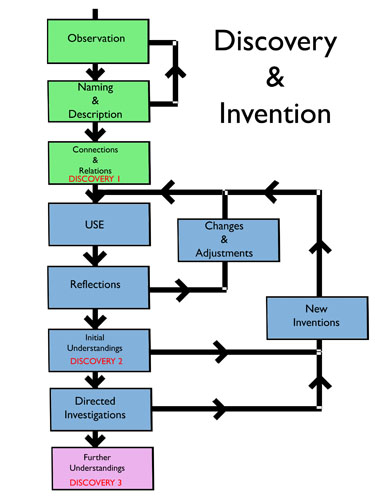
We plan to use this blog to post some of the many diagrams I have created over the years. Some of these will be published in the Shape Journal - we will link to it if there is an associated paper. Some of them are just little ideas to get you thinking!
For many years I have been struggling with the Philosophy of Science, and my efforts have not been helped by the fact that I do not sit with the consensus in this crucial area. Indeed, I am considered something of a maverick, in that I have long opposed the generally accepted philosophical position in my own subject - Physics. I have found, that to marshal my arguments effectively, I have had to go beyond the exclusive use of words. In revealing my position on the Philosophy of Science I have felt it essential to reveal relationships via diagrams...
The above quote is from A Structure of Diagrams, a series of papers to be published on the Shape website.
The first of which can be found here
26 June, 2009
SHAPE Journal Issue 1 now available
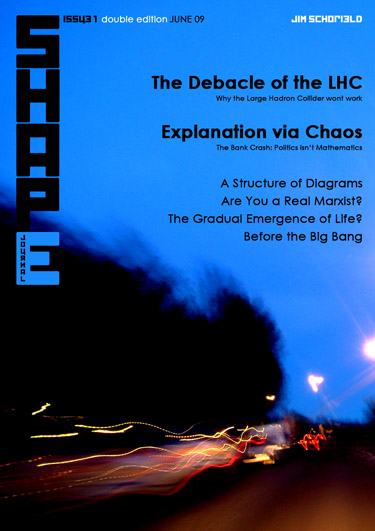 Issue 1 of my new journal SHAPE (Science, Holism, Abstraction, Philosophy, Emergence) is now available for free from E-Journal.org.uk here
Issue 1 of my new journal SHAPE (Science, Holism, Abstraction, Philosophy, Emergence) is now available for free from E-Journal.org.uk hereThe issue includes six articles (all papers from larger series that will be published over future issues) covering a wide variety of subjects including The Debacle of the Large Hadron Collider - why it won't work! Explanation via Chaos - a paper on the bank crash - why politics can't be explained by Chaos theory. A Structure of Diagrams, Are You A Real Marxist, The Gradual Emergence of Life, Before The Big Bang - quite a set for Issue 1 I think you'll agree! The website also features bonus series in the archive - The Nature of Form, The Nature of Reality, Emergence & Reductionism and The Philosophy of Mathematics each featuring a set of two or more papers.
All papers are available as PDF downloads so you can print them off easily and read them at your leisure.
We are also looking for submissions by other authors and scientists for the journal. If you are interested in participating or have any comments on any of the topics, leave them here or visit our contact page
Happy reading!
Editorial from Issue 1:
Welcome to the SHAPE Journal.
In this double Launch Issue we will begin with six sequences of papers on a wide variety of topics. We unashamedly concentrate on Philosophy as the essential and universal approach to human understanding of the world, but, as you will soon see, reject totally its usual academic and remarkably opaque form. Philosophy is too important to be sidelined into esoteric territory for a privileged intelligentsia. It is essential for everybody, yet never so addressed!
Therefore, all our Strands (categories), though all part of our conception of Philosophy, will range across a very wide spectrum of disciplines that would usually be placed elsewhere. This initial selection will give an idea of what we will be discussing. Perhaps the most important papers, which commence here, are not what you would expect to find in an academic Journal, but the separation into clearly distinct disciplines is without doubt at the very heart of what is wrong with them. They are usually hermetically sealed compartments, which admit of NO all embracing approach. Well, that essential World View standpoint is precisely what we mean this Journal to be all about.
The paper Explanation via Chaos is a thorough-going criticism of a BBC TV programme (High Anxieties) which attempted to explain the World Bank crisis of Autumn 2008 as a result of unavoidable mathematical Chaos, and hence "nobody's fault". The second major article The Debacle of the Large Hadron Collider was, once again, in response to a "popularising" TV programme on this amazing billion dollar venture, and tackles the by now century-long crisis of these physicists locked into the cul de sac of the Copenhagen Interpretation of Quantum Theory. Four other papers cover topics as far apart as Marxism, the techniques of Realisation via Diagrams, what came before the Big Bang and finally the myth of the gradual Emergence of Life on Earth. Quite a set, I think you will agree!
This first double issue will hope to establish our remit, and subsequent issues will continue with already commenced sequences of papers, and also introduce new concerns in each and every new publication. We sincerely invite comments and contributions, but please note that the initiators will not accept everything that is offered. This does not mean we will reject articles which oppose previous contributions to the Journal. Open debate is essential in this vital area. Please join in and make Philosophy the real search for Truth that it was always meant to be! This is the Shape of things to come...
Jim Schofield
JUNE 2009
14 March, 2009
E Journal begins...
Once my new website "E Journal" is up and running, I'll post up here the latest news, papers and articles etc. I will also add anything that I think may be of interest to E Journal's readers...




